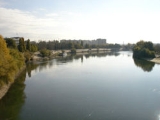
Tiraspol
Encyclopedia
Tiraspol is the second largest city in Moldova
and is the capital and administrative centre of the unrecognized Pridnestrovian Moldavian Republic
(Transnistria
). The city is located on the eastern bank of the Dniester River
. Tiraspol is a regional hub of light industry
, such as furniture and electrical goods production.
The modern city of Tiraspol was founded by the Russian generalissimo
Alexander Suvorov
in 1792, although the area had been inhabited for thousands of years by varying ethnic groups. The city celebrates its anniversary every year on October 14.
— the ancient Greek
name for the Dniester River, and polis
, i.e., a city.
, also spelled Tiras, was a colony of the Greek
city Miletus
, probably founded about 600 BCE
, situated some 10 km. from the mouth of the Tiras River (Dniester). Of no great importance in early times in the 2nd century BCE, it fell under the dominion of indigenous
kings whose names appear on its coins. It was destroyed by the Getae
about 50 BCE.
In CE 56 the Romans
restored the city and made it part of the colonial province of Lower Moesia. A series of its coins exist that feature heads of Roman emperors from Domitian
to Alexander Severus
. Soon after the time of the latter, the city was destroyed again, this time by the invasion of the Goths
. Its government was in the hands of five archon
s, a senate
, a popular assembly and a registrar. The images on its coins from this period suggest a trade in wheat, wine and fish. The few inscriptions extant are mostly concerned with trade.
Such ancient archeological remains are scanty, as the city site was built over by the great medieval fortress of Monocastro or Akkerman. During the Middle Ages
, the area around Tiraspol was a buffer zone between the Tatars
and the Moldavians, and inhabited by both ethnic groups.
conquered its way to the Dniester
River, taking territory from the Ottoman Empire
. In 1792, the Russian army built some fortifications to guard the western border near a Moldavian village named Sucleia
. Field Marshal Alexander Suvorov
is considered the founder of modern Tiraspol; his statue is city's most distinctive landmark. The city was named after Tyras, the Latin
name of the Dniester River on which it was built.
In 1828 the Russian government established a customs house in Tiraspol to try to suppress smuggling
. The customs house was subordinated to the chief of the Odessa
customs region. It began operations with 14 employees. They inspected shipments of bread, paper, oil, wine, sugar, fruits and other goods.
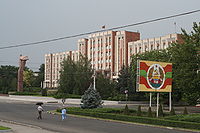
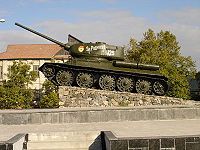
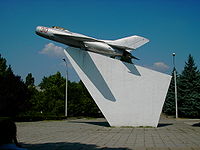
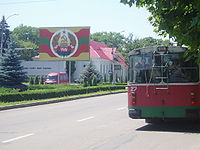
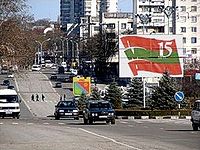 After the Russian Revolution, the Moldavian Autonomous Soviet Socialist Republic was created in Ukraine
After the Russian Revolution, the Moldavian Autonomous Soviet Socialist Republic was created in Ukraine
in 1924, with Balta
as its capital. The republic had Romanian
, Ukrainian
and Russian
as its official languages. Its capital was moved in 1929 to Tiraspol, which remained the capital of the Moldavian ASSR until 1940.
In 1940, following the secret provisions of the Molotov-Ribbentrop Pact
, the USSR forced Romania to cede Bessarabia. It integrated Tiraspol, until then part of the Ukrainian SSR
, into the newly-formed Moldavian SSR
. On August 7, 1941, following the Axis invasion of the Soviet Union
, the city was taken over by Romanian troops
. During the occupation, Tiraspol was under Romanian administration. During that period almost all of its Jewish population perished: they were murdered in place or deported to German Nazi concentration camps, where they were killed.
In 1941 before the occupation, the newspaper Dnestrovskaya pravda was founded by the Tiraspol City Council of popular deputies. This is the oldest periodical publication in the region. On April 12, 1944, the city was retaken by the Red Army
and became again part of Moldavian SSR.
declaring the city as an independent territory
. The nearby city of Bendery
also declared its independence from Moldova
. As the Russian-speaking
independence movement gained momentum, some local governments banded together to resist pressure from the Moldovan government for nationalization.
On September 2, 1990, Tiraspol was proclaimed the capital of the new Pridnestrovian Moldavian Soviet Socialist Republic
. The new republic was not officially recognized by Soviet authorities; however, it received support from some important Soviet leaders, such as Anatoly Lukyanov
. After the dissolution of the Soviet Union, the territory east of the Dniester River declared independence as the Pridnestrovian Moldavian Republic
(PMR), with Tiraspol as its capital. It was not recognized by the international community.
On July 1, 2005, the Lucian Blaga Lyceum, a high school with Romanian as its language of instruction, was registered as a Transnistrian non-governmental establishment. The registration of six Romanian language schools
has been the subject of negotiations with the government since 2000. The tension increased in the summer of 2004, when the Transnistrian authorities forcibly closed the schools that used the Moldovan language
in the Latin
script. According to the official PMR
view, this is considered as Romanian
. Moldovan, written in the Cyrillic script, is one of the three official languages in the PMR; Romanian is not. Some economic measures and counter-measures were taken on both banks of the Dniester.
Tensions have been expressed in terrorist incidents. On July 6, 2006, an explosion, believed to be caused by a bomb, killed at least eight people in a minibus. On August 13, 2006, a grenade explosion in a trolleybus
kills two, injures ten.
that closely borders an oceanic climate
. Summers are mild, with average monthly temperatures at around 21 °C (70 °F) in July and August. Winters are cold, with average temperatures in the coldest month (January) at -2.7 °C. Precipitation is relatively evenly spread throughout the year, though there is a noticeable increase in monthly precipitation in June and July. Tiraspol on average sees nearly 500 mm (19.69 in) of precipitation per year.
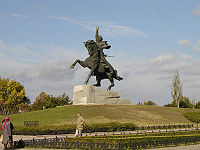 The statue of Alexander Suvorov
The statue of Alexander Suvorov
was erected in the central square in 1979 in commemoration of his 250th anniversary. In front of the Transnistrian Government building there is a statue of Lenin. On the opposite side of the central square, a monument plaza features a Soviet T-34
tank, commemorating the Soviet victory in World War II
, an eternal flame to those who fell defending the city in 1941 and liberating it in 1944, as well as several monuments dedicated to more recent conflicts, including the Soviet war in Afghanistan
and the War of Transnistria
.
, 32% Ukrainians
and 18% were Moldovans
. As result of the political and economic situation that followed the proclamation of the independent (unrecognized) Pridnestrovian Moldavian Republic
, as well as large Jewish emigration in the early 1990s, the population of the city fell below its 1989 number and the 2004 Census in Transnistria
puts its current population at 158,069.
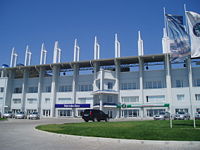 There are two professional football clubs in Tiraspol, playing in the Divizia Naţională
There are two professional football clubs in Tiraspol, playing in the Divizia Naţională
, the top Moldovan football league: FC Sheriff Tiraspol
& FC Tiraspol
. Sheriff are the most successful Moldovan football club of recent history, winning every league title since the 2000-2001 season, and 6 Moldovan Cups. A third club, CS Tiligul-Tiras Tiraspol
, withdrew from competition prior to the 2009-2010 season. Tiraspol is home to the Sheriff Stadium
, the biggest seated stadium in the region with a capacity of 14,300.
Moldova
Moldova , officially the Republic of Moldova is a landlocked state in Eastern Europe, located between Romania to the West and Ukraine to the North, East and South. It declared itself an independent state with the same boundaries as the preceding Moldavian Soviet Socialist Republic in 1991, as part...
and is the capital and administrative centre of the unrecognized Pridnestrovian Moldavian Republic
Transnistria
Transnistria is a breakaway territory located mostly on a strip of land between the Dniester River and the eastern Moldovan border to Ukraine...
(Transnistria
Transnistria
Transnistria is a breakaway territory located mostly on a strip of land between the Dniester River and the eastern Moldovan border to Ukraine...
). The city is located on the eastern bank of the Dniester River
Dniester
The Dniester is a river in Eastern Europe. It runs through Ukraine and Moldova and separates most of Moldova's territory from the breakaway de facto state of Transnistria.-Names:...
. Tiraspol is a regional hub of light industry
Light industry
Light industry is usually less capital intensive than heavy industry, and is more consumer-oriented than business-oriented...
, such as furniture and electrical goods production.
The modern city of Tiraspol was founded by the Russian generalissimo
Generalissimo
Generalissimo and Generalissimus are military ranks of the highest degree, superior to Field Marshal and other five-star ranks.-Usage:...
Alexander Suvorov
Alexander Suvorov
Alexander Vasilyevich Suvorov , Count Suvorov of Rymnik, Prince in Italy, Count of the Holy Roman Empire , was the fourth and last generalissimo of the Russian Empire.One of the few great generals in history who never lost a battle along with the likes of Alexander...
in 1792, although the area had been inhabited for thousands of years by varying ethnic groups. The city celebrates its anniversary every year on October 14.
Name
The toponym consists of two words: Τύρας, TyrasTyras
Tyras , was an ancient Greek city founded as colony of Miletus, probably about 600 BC, situated some 10 m from the mouth of the Tyras River...
— the ancient Greek
Ancient Greek
Ancient Greek is the stage of the Greek language in the periods spanning the times c. 9th–6th centuries BC, , c. 5th–4th centuries BC , and the c. 3rd century BC – 6th century AD of ancient Greece and the ancient world; being predated in the 2nd millennium BC by Mycenaean Greek...
name for the Dniester River, and polis
Polis
Polis , plural poleis , literally means city in Greek. It could also mean citizenship and body of citizens. In modern historiography "polis" is normally used to indicate the ancient Greek city-states, like Classical Athens and its contemporaries, so polis is often translated as "city-state."The...
, i.e., a city.
Pre-history
TyrasTyras
Tyras , was an ancient Greek city founded as colony of Miletus, probably about 600 BC, situated some 10 m from the mouth of the Tyras River...
, also spelled Tiras, was a colony of the Greek
Greece
Greece , officially the Hellenic Republic , and historically Hellas or the Republic of Greece in English, is a country in southeastern Europe....
city Miletus
Miletus
Miletus was an ancient Greek city on the western coast of Anatolia , near the mouth of the Maeander River in ancient Caria...
, probably founded about 600 BCE
Common Era
Common Era ,abbreviated as CE, is an alternative designation for the calendar era originally introduced by Dionysius Exiguus in the 6th century, traditionally identified with Anno Domini .Dates before the year 1 CE are indicated by the usage of BCE, short for Before the Common Era Common Era...
, situated some 10 km. from the mouth of the Tiras River (Dniester). Of no great importance in early times in the 2nd century BCE, it fell under the dominion of indigenous
Indigenous peoples
Indigenous peoples are ethnic groups that are defined as indigenous according to one of the various definitions of the term, there is no universally accepted definition but most of which carry connotations of being the "original inhabitants" of a territory....
kings whose names appear on its coins. It was destroyed by the Getae
Getae
The Getae was the name given by the Greeks to several Thracian tribes that occupied the regions south of the Lower Danube, in what is today northern Bulgaria, and north of the Lower Danube, in Romania...
about 50 BCE.
In CE 56 the Romans
Roman Republic
The Roman Republic was the period of the ancient Roman civilization where the government operated as a republic. It began with the overthrow of the Roman monarchy, traditionally dated around 508 BC, and its replacement by a government headed by two consuls, elected annually by the citizens and...
restored the city and made it part of the colonial province of Lower Moesia. A series of its coins exist that feature heads of Roman emperors from Domitian
Domitian
Domitian was Roman Emperor from 81 to 96. Domitian was the third and last emperor of the Flavian dynasty.Domitian's youth and early career were largely spent in the shadow of his brother Titus, who gained military renown during the First Jewish-Roman War...
to Alexander Severus
Alexander Severus
Severus Alexander was Roman Emperor from 222 to 235. Alexander was the last emperor of the Severan dynasty. He succeeded his cousin Elagabalus upon the latter's assassination in 222, and was ultimately assassinated himself, marking the epoch event for the Crisis of the Third Century — nearly fifty...
. Soon after the time of the latter, the city was destroyed again, this time by the invasion of the Goths
Goths
The Goths were an East Germanic tribe of Scandinavian origin whose two branches, the Visigoths and the Ostrogoths, played an important role in the fall of the Roman Empire and the emergence of Medieval Europe....
. Its government was in the hands of five archon
Archon
Archon is a Greek word that means "ruler" or "lord", frequently used as the title of a specific public office. It is the masculine present participle of the verb stem ἀρχ-, meaning "to rule", derived from the same root as monarch, hierarchy, and anarchy.- Ancient Greece :In ancient Greece the...
s, a senate
Senate
A senate is a deliberative assembly, often the upper house or chamber of a legislature or parliament. There have been many such bodies in history, since senate means the assembly of the eldest and wiser members of the society and ruling class...
, a popular assembly and a registrar. The images on its coins from this period suggest a trade in wheat, wine and fish. The few inscriptions extant are mostly concerned with trade.
Such ancient archeological remains are scanty, as the city site was built over by the great medieval fortress of Monocastro or Akkerman. During the Middle Ages
Middle Ages
The Middle Ages is a periodization of European history from the 5th century to the 15th century. The Middle Ages follows the fall of the Western Roman Empire in 476 and precedes the Early Modern Era. It is the middle period of a three-period division of Western history: Classic, Medieval and Modern...
, the area around Tiraspol was a buffer zone between the Tatars
Tatars
Tatars are a Turkic speaking ethnic group , numbering roughly 7 million.The majority of Tatars live in the Russian Federation, with a population of around 5.5 million, about 2 million of which in the republic of Tatarstan.Significant minority populations are found in Uzbekistan, Kazakhstan,...
and the Moldavians, and inhabited by both ethnic groups.
Foundation
The Russian EmpireRussian Empire
The Russian Empire was a state that existed from 1721 until the Russian Revolution of 1917. It was the successor to the Tsardom of Russia and the predecessor of the Soviet Union...
conquered its way to the Dniester
Dniester
The Dniester is a river in Eastern Europe. It runs through Ukraine and Moldova and separates most of Moldova's territory from the breakaway de facto state of Transnistria.-Names:...
River, taking territory from the Ottoman Empire
Ottoman Empire
The Ottoman EmpireIt was usually referred to as the "Ottoman Empire", the "Turkish Empire", the "Ottoman Caliphate" or more commonly "Turkey" by its contemporaries...
. In 1792, the Russian army built some fortifications to guard the western border near a Moldavian village named Sucleia
Sucleia
Sucleia is a commune in the Slobozia sub-district of Transnistria, Moldova. It is composed of a single village, Sucleia. It is currently under the administration of the breakaway government of the Transnistrian Moldovan Republic....
. Field Marshal Alexander Suvorov
Alexander Suvorov
Alexander Vasilyevich Suvorov , Count Suvorov of Rymnik, Prince in Italy, Count of the Holy Roman Empire , was the fourth and last generalissimo of the Russian Empire.One of the few great generals in history who never lost a battle along with the likes of Alexander...
is considered the founder of modern Tiraspol; his statue is city's most distinctive landmark. The city was named after Tyras, the Latin
Latin
Latin is an Italic language originally spoken in Latium and Ancient Rome. It, along with most European languages, is a descendant of the ancient Proto-Indo-European language. Although it is considered a dead language, a number of scholars and members of the Christian clergy speak it fluently, and...
name of the Dniester River on which it was built.
In 1828 the Russian government established a customs house in Tiraspol to try to suppress smuggling
Smuggling
Smuggling is the clandestine transportation of goods or persons, such as out of a building, into a prison, or across an international border, in violation of applicable laws or other regulations.There are various motivations to smuggle...
. The customs house was subordinated to the chief of the Odessa
Odessa
Odessa or Odesa is the administrative center of the Odessa Oblast located in southern Ukraine. The city is a major seaport located on the northwest shore of the Black Sea and the fourth largest city in Ukraine with a population of 1,029,000 .The predecessor of Odessa, a small Tatar settlement,...
customs region. It began operations with 14 employees. They inspected shipments of bread, paper, oil, wine, sugar, fruits and other goods.
20th century - Soviet Tiraspol





Ukraine
Ukraine is a country in Eastern Europe. It has an area of 603,628 km², making it the second largest contiguous country on the European continent, after Russia...
in 1924, with Balta
Balta, Ukraine
Balta is a small city in the Odessa Oblast of south-western Ukraine. It is the administrative center of the Baltsky Raion , and located approximately 200 kilometers from the oblast capital, Odessa...
as its capital. The republic had Romanian
Romanian language
Romanian Romanian Romanian (or Daco-Romanian; obsolete spellings Rumanian, Roumanian; self-designation: română, limba română ("the Romanian language") or românește (lit. "in Romanian") is a Romance language spoken by around 24 to 28 million people, primarily in Romania and Moldova...
, Ukrainian
Ukrainian language
Ukrainian is a language of the East Slavic subgroup of the Slavic languages. It is the official state language of Ukraine. Written Ukrainian uses a variant of the Cyrillic alphabet....
and Russian
Russian language
Russian is a Slavic language used primarily in Russia, Belarus, Uzbekistan, Kazakhstan, Tajikistan and Kyrgyzstan. It is an unofficial but widely spoken language in Ukraine, Moldova, Latvia, Turkmenistan and Estonia and, to a lesser extent, the other countries that were once constituent republics...
as its official languages. Its capital was moved in 1929 to Tiraspol, which remained the capital of the Moldavian ASSR until 1940.
In 1940, following the secret provisions of the Molotov-Ribbentrop Pact
Molotov-Ribbentrop Pact
The Molotov–Ribbentrop Pact, named after the Soviet foreign minister Vyacheslav Molotov and the German foreign minister Joachim von Ribbentrop, was an agreement officially titled the Treaty of Non-Aggression between Germany and the Soviet Union and signed in Moscow in the late hours of 23 August 1939...
, the USSR forced Romania to cede Bessarabia. It integrated Tiraspol, until then part of the Ukrainian SSR
Ukrainian SSR
The Ukrainian Soviet Socialist Republic or in short, the Ukrainian SSR was a sovereign Soviet Socialist state and one of the fifteen constituent republics of the Soviet Union lasting from its inception in 1922 to the breakup in 1991...
, into the newly-formed Moldavian SSR
Moldavian SSR
The Moldavian Soviet Socialist Republic , commonly abbreviated to Moldavian SSR or MSSR, was one of the 15 republics of the Soviet Union...
. On August 7, 1941, following the Axis invasion of the Soviet Union
Operation Barbarossa
Operation Barbarossa was the code name for Germany's invasion of the Soviet Union during World War II that began on 22 June 1941. Over 4.5 million troops of the Axis powers invaded the USSR along a front., the largest invasion in the history of warfare...
, the city was taken over by Romanian troops
Romania during World War II
Following the outbreak of World War II on 1 September 1939, the Kingdom of Romania officially adopted a position of neutrality. However, the rapidly changing situation in Europe during 1940, as well as domestic political upheaval, undermined this stance. Fascist political forces such as the Iron...
. During the occupation, Tiraspol was under Romanian administration. During that period almost all of its Jewish population perished: they were murdered in place or deported to German Nazi concentration camps, where they were killed.
In 1941 before the occupation, the newspaper Dnestrovskaya pravda was founded by the Tiraspol City Council of popular deputies. This is the oldest periodical publication in the region. On April 12, 1944, the city was retaken by the Red Army
Red Army
The Workers' and Peasants' Red Army started out as the Soviet Union's revolutionary communist combat groups during the Russian Civil War of 1918-1922. It grew into the national army of the Soviet Union. By the 1930s the Red Army was among the largest armies in history.The "Red Army" name refers to...
and became again part of Moldavian SSR.
After independence
On January 27, 1990, the citizens in Tiraspol passed a referendumReferendum
A referendum is a direct vote in which an entire electorate is asked to either accept or reject a particular proposal. This may result in the adoption of a new constitution, a constitutional amendment, a law, the recall of an elected official or simply a specific government policy. It is a form of...
declaring the city as an independent territory
Independence
Independence is a condition of a nation, country, or state in which its residents and population, or some portion thereof, exercise self-government, and usually sovereignty, over its territory....
. The nearby city of Bendery
Bender, Moldova
Bender or Bendery, also known as Tighina is a city within the internationally recognized borders of Moldova under de facto control of the unrecognized Transnistria Republic since 1992...
also declared its independence from Moldova
Moldova
Moldova , officially the Republic of Moldova is a landlocked state in Eastern Europe, located between Romania to the West and Ukraine to the North, East and South. It declared itself an independent state with the same boundaries as the preceding Moldavian Soviet Socialist Republic in 1991, as part...
. As the Russian-speaking
Russian language
Russian is a Slavic language used primarily in Russia, Belarus, Uzbekistan, Kazakhstan, Tajikistan and Kyrgyzstan. It is an unofficial but widely spoken language in Ukraine, Moldova, Latvia, Turkmenistan and Estonia and, to a lesser extent, the other countries that were once constituent republics...
independence movement gained momentum, some local governments banded together to resist pressure from the Moldovan government for nationalization.
On September 2, 1990, Tiraspol was proclaimed the capital of the new Pridnestrovian Moldavian Soviet Socialist Republic
Pridnestrovian Moldavian Soviet Socialist Republic
The Pridnestrovian Moldavian Soviet Socialist Republic was created on the eastern periphery of the Moldavian Soviet Socialist Republic in 1990 by pro-Soviet separatists who hoped to remain within the Soviet Union when it became clear that the MSSR would achieve independence from the USSR...
. The new republic was not officially recognized by Soviet authorities; however, it received support from some important Soviet leaders, such as Anatoly Lukyanov
Anatoly Lukyanov
Anatoly Ivanovich Lukyanov is a Russian Communist politician who was the Chairman of the Supreme Soviet of the USSR between 15 March 1990 and 22 August 1991. One of the founders of the Communist Party of the Russian Federation in 1993, he is described by its leader Gennady Zyuganov as the "Deng...
. After the dissolution of the Soviet Union, the territory east of the Dniester River declared independence as the Pridnestrovian Moldavian Republic
Transnistria
Transnistria is a breakaway territory located mostly on a strip of land between the Dniester River and the eastern Moldovan border to Ukraine...
(PMR), with Tiraspol as its capital. It was not recognized by the international community.
On July 1, 2005, the Lucian Blaga Lyceum, a high school with Romanian as its language of instruction, was registered as a Transnistrian non-governmental establishment. The registration of six Romanian language schools
Moldovan schools in Transnistria
The Moldovan schools in Transnistria became an issue of contention in 2004 in the context of the disputed status of Transnistria, a breakaway region of since 1990/1992.- History :...
has been the subject of negotiations with the government since 2000. The tension increased in the summer of 2004, when the Transnistrian authorities forcibly closed the schools that used the Moldovan language
Moldovan language
Moldovan is one of the names of the Romanian language as spoken in the Republic of Moldova, where it is official. The spoken language of Moldova is closer to the dialects of Romanian spoken in northeastern Romania, and the two countries share the same literary standard...
in the Latin
Latin
Latin is an Italic language originally spoken in Latium and Ancient Rome. It, along with most European languages, is a descendant of the ancient Proto-Indo-European language. Although it is considered a dead language, a number of scholars and members of the Christian clergy speak it fluently, and...
script. According to the official PMR
PMR
-Health and medicine:* physical medicine and rehabilitation* polymyalgia rheumatica, inflammatory condition of the muscles* profound mental retardation, a developmental disability* progressive muscle relaxation, an anxiety reduction technique...
view, this is considered as Romanian
Romanian language
Romanian Romanian Romanian (or Daco-Romanian; obsolete spellings Rumanian, Roumanian; self-designation: română, limba română ("the Romanian language") or românește (lit. "in Romanian") is a Romance language spoken by around 24 to 28 million people, primarily in Romania and Moldova...
. Moldovan, written in the Cyrillic script, is one of the three official languages in the PMR; Romanian is not. Some economic measures and counter-measures were taken on both banks of the Dniester.
Tensions have been expressed in terrorist incidents. On July 6, 2006, an explosion, believed to be caused by a bomb, killed at least eight people in a minibus. On August 13, 2006, a grenade explosion in a trolleybus
Trolleybus
A trolleybus is an electric bus that draws its electricity from overhead wires using spring-loaded trolley poles. Two wires and poles are required to complete the electrical circuit...
kills two, injures ten.
Jewish history
- 1847: JewishJudaismJudaism ) is the "religion, philosophy, and way of life" of the Jewish people...
population in Tiraspol amounted to 1,406. - 1897: Jewish population rose to 8,668 (27% of the total population).
- 1910: Tiraspol had two Jewish private schools, one for boys and one for girls.
- 1926: There were 6,398 Jews (29.1%) in the town.
- 1941-1944 - Most of the Jewish population was deported to concentration camps and killed.
- 1959: The only synagogueSynagogueA synagogue is a Jewish house of prayer. This use of the Greek term synagogue originates in the Septuagint where it sometimes translates the Hebrew word for assembly, kahal...
was closed by the authorities. - 1960's: The Jewish population was estimated at about 1,500.
- 14–15 April 2001: the Synagogue of Tiraspol suffered a pipe bombPipe bombA pipe bomb is an improvised explosive device, a tightly sealed section of pipe filled with an explosive material. The containment provided by the pipe means that simple low explosives can be used to produce a relatively large explosion, and the fragmentation of the pipe itself creates potentially...
attack. The building was damaged, but the guard was not hurt. - 13–30 March 2004: Over 70 tombstones in the Jewish cemetery of Tiraspol were vandalized Local community leaders said the authorities refused to help clean up the graffiti painted over the tombstones
- 4 May 2004: Vandals threw a Molotov cocktailMolotov cocktailThe Molotov cocktail, also known as the petrol bomb, gasoline bomb, Molotov bomb, fire bottle, fire bomb, or simply Molotov, is a generic name used for a variety of improvised incendiary weapons...
in an attempt to set fire to a synagogue in Tiraspol The attack failed when passers-by extinguished the fire. - 2007: Jewish population of Tiraspol is 2,200.
Climate
Tiraspol features a humid continental climateHumid continental climate
A humid continental climate is a climatic region typified by large seasonal temperature differences, with warm to hot summers and cold winters....
that closely borders an oceanic climate
Oceanic climate
An oceanic climate, also called marine west coast climate, maritime climate, Cascadian climate and British climate for Köppen climate classification Cfb and subtropical highland for Köppen Cfb or Cwb, is a type of climate typically found along the west coasts at the middle latitudes of some of the...
. Summers are mild, with average monthly temperatures at around 21 °C (70 °F) in July and August. Winters are cold, with average temperatures in the coldest month (January) at -2.7 °C. Precipitation is relatively evenly spread throughout the year, though there is a noticeable increase in monthly precipitation in June and July. Tiraspol on average sees nearly 500 mm (19.69 in) of precipitation per year.
Monuments

Alexander Suvorov
Alexander Vasilyevich Suvorov , Count Suvorov of Rymnik, Prince in Italy, Count of the Holy Roman Empire , was the fourth and last generalissimo of the Russian Empire.One of the few great generals in history who never lost a battle along with the likes of Alexander...
was erected in the central square in 1979 in commemoration of his 250th anniversary. In front of the Transnistrian Government building there is a statue of Lenin. On the opposite side of the central square, a monument plaza features a Soviet T-34
T-34
The T-34 was a Soviet medium tank produced from 1940 to 1958. Although its armour and armament were surpassed by later tanks of the era, it has been often credited as the most effective, efficient and influential design of World War II...
tank, commemorating the Soviet victory in World War II
World War II
World War II, or the Second World War , was a global conflict lasting from 1939 to 1945, involving most of the world's nations—including all of the great powers—eventually forming two opposing military alliances: the Allies and the Axis...
, an eternal flame to those who fell defending the city in 1941 and liberating it in 1944, as well as several monuments dedicated to more recent conflicts, including the Soviet war in Afghanistan
Soviet war in Afghanistan
The Soviet war in Afghanistan was a nine-year conflict involving the Soviet Union, supporting the Marxist-Leninist government of the Democratic Republic of Afghanistan against the Afghan Mujahideen and foreign "Arab–Afghan" volunteers...
and the War of Transnistria
War of Transnistria
The War of Transnistria was a limited conflict that broke out in November 1990 at Dubăsari between pro-Transnistria forces, including the Transnistrian Republican Guard, militia and Cossack units, and supported by elements of the Russian 14th army, and pro-Moldovan forces, including Moldovan...
.
Demographics
In 1989 the city had a population of about 190,000 and in 1992 203,000. 41% were RussiansRussians
The Russian people are an East Slavic ethnic group native to Russia, speaking the Russian language and primarily living in Russia and neighboring countries....
, 32% Ukrainians
Ukrainians
Ukrainians are an East Slavic ethnic group native to Ukraine, which is the sixth-largest nation in Europe. The Constitution of Ukraine applies the term 'Ukrainians' to all its citizens...
and 18% were Moldovans
Moldovans
Moldovans or Moldavians are the largest population group of Moldova...
. As result of the political and economic situation that followed the proclamation of the independent (unrecognized) Pridnestrovian Moldavian Republic
Transnistria
Transnistria is a breakaway territory located mostly on a strip of land between the Dniester River and the eastern Moldovan border to Ukraine...
, as well as large Jewish emigration in the early 1990s, the population of the city fell below its 1989 number and the 2004 Census in Transnistria
2004 Census in Transnistria
The 2004 Census in Transnistria was organized in Transnistria at roughly the same time that Moldova held its own census, which Transnistria refused to participate in out of principle and deference to its September 2, 1990 Declaration of Independence....
puts its current population at 158,069.
| Ethnic composition | |||||
| Ethnic group | 1959 census | 1970 census | 1979 census | 1989 census | 2004 census |
| Russians Russians The Russian people are an East Slavic ethnic group native to Russia, speaking the Russian language and primarily living in Russia and neighboring countries.... |
N/A | N/A | N/A | N/A | 65,928 |
| Ukrainians Ukrainians Ukrainians are an East Slavic ethnic group native to Ukraine, which is the sixth-largest nation in Europe. The Constitution of Ukraine applies the term 'Ukrainians' to all its citizens... |
N/A | N/A | N/A | N/A | 52,278 |
| Moldovans Moldovans Moldovans or Moldavians are the largest population group of Moldova... (Romanians Romanians The Romanians are an ethnic group native to Romania, who speak Romanian; they are the majority inhabitants of Romania.... ) |
N/A | N/A | N/A | N/A | 23,790 |
| Bulgarians Bulgarians The Bulgarians are a South Slavic nation and ethnic group native to Bulgaria and neighbouring regions. Emigration has resulted in immigrant communities in a number of other countries.-History and ethnogenesis:... |
N/A | N/A | N/A | N/A | 2,450 |
| Gagauzians | N/A | N/A | N/A | N/A | 1,988 |
| Belorussians | N/A | N/A | N/A | N/A | 1,712 |
| Germans Germans The Germans are a Germanic ethnic group native to Central Europe. The English term Germans has referred to the German-speaking population of the Holy Roman Empire since the Late Middle Ages.... |
N/A | N/A | N/A | N/A | 701 |
| Jews Jews The Jews , also known as the Jewish people, are a nation and ethnoreligious group originating in the Israelites or Hebrews of the Ancient Near East. The Jewish ethnicity, nationality, and religion are strongly interrelated, as Judaism is the traditional faith of the Jewish nation... |
N/A | N/A | N/A | N/A | 573 |
| Armenians Armenians Armenian people or Armenians are a nation and ethnic group native to the Armenian Highland.The largest concentration is in Armenia having a nearly-homogeneous population with 97.9% or 3,145,354 being ethnic Armenian.... |
N/A | N/A | N/A | N/A | 360 |
| Poles Poles thumb|right|180px|The state flag of [[Poland]] as used by Polish government and diplomatic authoritiesThe Polish people, or Poles , are a nation indigenous to Poland. They are united by the Polish language, which belongs to the historical Lechitic subgroup of West Slavic languages of Central Europe... |
N/A | N/A | N/A | N/A | 324 |
| Roma | N/A | N/A | N/A | N/A | 116 |
| others, non-declared | N/A | N/A | N/A | N/A | 7,849
|
| Total | 62,000 | 105,700 | 138,698 | 181,862 | 158,069 |
Sport

Divizia Nationala
The Moldovan National Division is the top division of association football in Moldova. There are 12 teams in the competition. At the end of the season, the bottom club is relegated to the "A" Division and replaced by the lower league's champion....
, the top Moldovan football league: FC Sheriff Tiraspol
FC Sheriff Tiraspol
FC Sheriff Tiraspol is a football club based in Tiraspol, Moldova. They play in the Divizia Naţională, the top division in Moldovan football. The team is sometimes referred to as simply FC Sheriff and should not be confused with FC Tiraspol, a rival team based in the same city.-History:The club...
& FC Tiraspol
FC Tiraspol
FC Tiraspol is a Moldovan football club based in Tiraspol, Pridnestrovian Moldavian Republic. They play in the Divizia Naţională, the top division in Moldovan football.- Current squad :As of 1st of August...
. Sheriff are the most successful Moldovan football club of recent history, winning every league title since the 2000-2001 season, and 6 Moldovan Cups. A third club, CS Tiligul-Tiras Tiraspol
CS Tiligul-Tiras Tiraspol
CS Tiligul-Tiras Tiraspol was a Moldovan football club based in Tiraspol. They played in the Divizia Naţională, the top division in Moldovan football. Their home stadium was Stadionul Municipal....
, withdrew from competition prior to the 2009-2010 season. Tiraspol is home to the Sheriff Stadium
Sheriff Stadium
Sheriff Stadium is home to Sheriff Tiraspol, a football team based in Tiraspol, capital of Transnistria, and owned by the local Sheriff corporation. It seats 14,300 spectators...
, the biggest seated stadium in the region with a capacity of 14,300.
Twin towns — Sister cities
| City | Country | Year |
|---|---|---|
| Trondheim Trondheim Trondheim , historically, Nidaros and Trondhjem, is a city and municipality in Sør-Trøndelag county, Norway. With a population of 173,486, it is the third most populous municipality and city in the country, although the fourth largest metropolitan area. It is the administrative centre of... |
 Norway NorwayNorway Norway , officially the Kingdom of Norway, is a Nordic unitary constitutional monarchy whose territory comprises the western portion of the Scandinavian Peninsula, Jan Mayen, and the Arctic archipelago of Svalbard and Bouvet Island. Norway has a total area of and a population of about 4.9 million... |
2000 |
| Tskhinvali Tskhinvali Tskhinvali , is the capital of South Ossetia, a disputed region which has been recognised as an independent Republic by Russia, Venezuela, Nicaragua and Nauru, and is regarded by Georgia and the rest of the world as part of the Shida Kartli region within Georgian sovereign territory.It is located... |
 South Ossetia South OssetiaSouth Ossetia South Ossetia or Tskhinvali Region is a disputed region and partly recognized state in the South Caucasus, located in the territory of the South Ossetian Autonomous Oblast within the former Georgian Soviet Socialist Republic.... |
|
| Severodvinsk Severodvinsk Severodvinsk is a city in the north of Arkhangelsk Oblast, Russia, located in the delta of the Northern Dvina River, west of Arkhangelsk. Administratively, it is incorporated as a town of oblast significance . Municipally, it is incorporated as Severodvinsk Urban Okrug. The city was founded as... |
 Russia Russia |
Non-Transnistrian links
Tyraspol (Tiraspol) in the Geographical Dictionary of the Kingdom of Poland (1892)- Current weather at Tiraspol from Yahoo
- Article about travelling to Tiraspol at Lonely PlanetLonely PlanetLonely Planet is the largest travel guide book and digital media publisher in the world. The company is owned by BBC Worldwide, which bought a 75% share from the founders Maureen and Tony Wheeler in 2007 and the final 25% in February 2011...
- Tiraspol on Google Maps
- Tiraspol telephone directory
- Yellow pages of Tiraspol
Transnistrian links
- Tiraspol.info (in Russian)

